Peritoneal mesothelioma survivor Tamron Little said she always pictured a day that she’d be cancer-free. Now, more than 14 years after her diagnosis and in remission, she reminds other survivors to make healthy lifestyle choices, monitor their health and advocate for themselves.
Mesothelioma
Mesothelioma is a cancer that forms tumors in the mesothelium, the thin tissue covering the internal organs. Asbestos exposure causes mesothelioma. The most common type is pleural mesothelioma, which affects the lining of the lungs. Surgery, chemotherapy and radiation treat symptoms like cough and breathlessness.
What Is Mesothelioma?
Mesothelioma is a deadly cancer that affects the smooth, protective tissue covering the lungs, abdomen, heart and testes. The primary cause of mesothelioma is exposure to asbestos fibers and dust, usually through occupational exposure. Doctors treat mesothelioma with surgery, chemotherapy, immunotherapy and radiation.
Life expectancy after diagnosis is 12 to 21 months with treatment. But some survivors have lived two, three or more years beyond that life expectancy. Kim Madril sought help from The Mesothelioma Center after her 2019 diagnosis, and she is still going strong today. “I am so happy that I’m still here,” Kim said. “Embrace the moment.”
Key Facts About Mesothelioma Cancer
- Most mesothelioma patients are 75 to 79 years old at the time of diagnosis.
- Doctors diagnose 3,000 new cases of mesothelioma each year.
- 80% of mesothelioma patients are white.
- Symptoms can take 20 to 60 years to appear after asbestos exposure.
Doctors classify mesothelioma into different types based on where tumors form on the mesothelium. These types have different treatment options, prognosis and life expectancy.
Mesothelioma Types
The two most common types of mesothelioma are pleural and peritoneal. In the pleural mesothelioma type, tumors form on the lung lining and chest wall. They also grow on the diaphragm and other thoracic areas.
Peritoneal mesothelioma tumors form on the peritoneum. It lines the abdominal organs and gut wall. Rarer types of mesothelioma include pericardial mesothelioma and testicular mesothelioma.
- Pleural Mesothelioma
-
The most common type of mesothelioma is pleural mesothelioma. It forms in the pleura, the protective lining around the outside of the lungs.
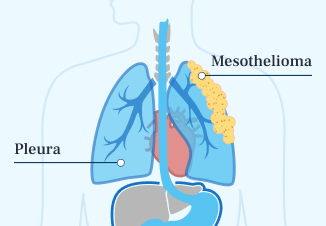
- Peritoneal Mesothelioma
-
Peritoneal mesothelioma, which forms in the abdominal lining, is the second-most common type. It has a much higher survival rate. Surgery is usually more successful than with pleural mesothelioma.
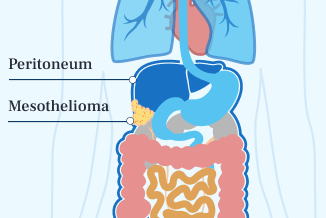
- Pericardial Mesothelioma
-
Pericardial mesothelioma affects about 1% of patients. Treatment options are much more limited. The median survival is 2 to 6 months.
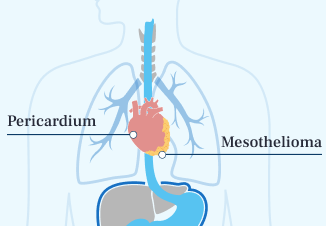
- Testicular Mesothelioma
-
The rarest type is testicular mesothelioma. Treatment options are much more limited. About one-third of patients live for at least 10 years.
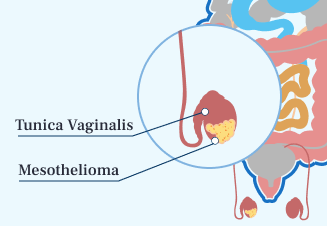
Symptoms of Mesothelioma
The most common symptoms of mesothelioma include fatigue, weight loss and fever. Symptoms usually develop 20 to 60 years after first exposure to asbestos, known as the mesothelioma latency period. Because of where the cancer forms in the body, symptoms vary depending on the type of mesothelioma.
Symptoms by Mesothelioma Type
- Pleural Mesothelioma: Chest pain, fatigue, fluid buildup around lungs (pleural effusion), persistent cough, shortness of breath and unexplained weight loss
- Peritoneal Mesothelioma: Abdominal pain or swelling, constipation or diarrhea, loss of appetite, nausea or vomiting, and weight loss
- Pericardial Mesothelioma: Chest pain, difficulty breathing, fatigue and irregular heartbeat
- Testicular Mesothelioma: Pain or discomfort in the groin area and swelling or lumps in the testes
These symptoms often are vague and similar to other less serious conditions. If you or a loved one is having these symptoms and has been exposed to asbestos, seek medical help from a mesothelioma specialist. Early diagnosis often leads to a better prognosis and longer life expectancy.
Learn about your diagnosis, top doctors and paying for treatment.
Get Your Free GuideDoctor-reviewed, ships overnight for free
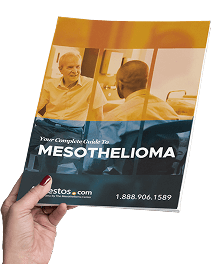
What Causes Mesothelioma?
Asbestos exposure is the leading cause of mesothelioma. Asbestos was mainly used in construction, manufacturing and other industries. When asbestos fibers are damaged or disturbed, they become airborne and could be inhaled.
Dr. Marcelo DaSilva, chief of thoracic surgery at AdventHealth Cancer Institute, said that once patients inhale asbestos, “it causes chronic inflammation in the mesothelium. This can lead to genetic changes where cell DNA becomes a mesothelioma cancer cell.”
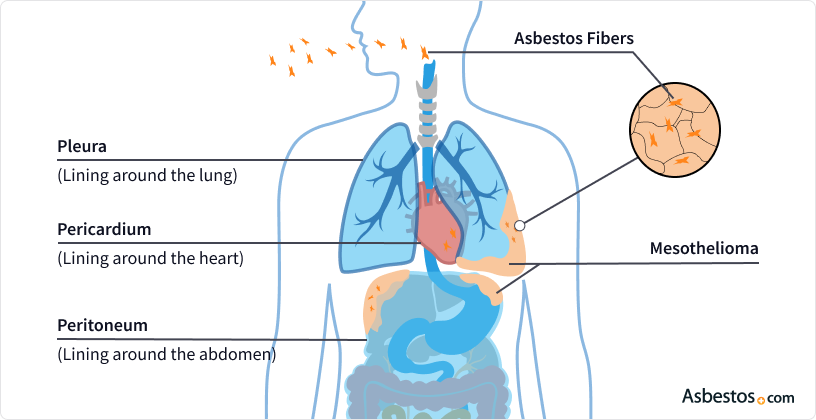
Who Is Most at Risk of Mesothelioma?
People who are regularly exposed to asbestos in the workplace are most at risk for mesothelioma. But there are also other factors, such as family history, gender, age and lifestyle, that may contribute to a higher risk.
Highest Risks of Exposure
- Occupational Exposure: Workers in industries such as construction, shipbuilding, automotive manufacturing and mining were often exposed to asbestos fibers.
- Secondary Exposure: Family members of workers exposed to asbestos can also be at risk if asbestos fibers were brought home on clothing, tools, hair and body.
- Environmental Exposure: People living near asbestos mines or factories might inhale asbestos particles in the air or ground.
Pleural mesothelioma survivor Carla Fasolo says she was exposed to asbestos at her dad’s job in a boiler room. “I would go down there with him, and it was very dusty in the boiler room,” Carla remembers. “There would be chunks of gray, fibrous stuff down there. I didn’t know what it was, but I’d pick it up and play with it.”
If any of these risk factors apply to you or a loved one, get screened for mesothelioma. X-rays and other tests can help catch mesothelioma early. Tell your doctor about your exposure and ask how frequently you should be screened.
How Is Mesothelioma Diagnosed?
Doctors diagnose mesothelioma using a combination of examinations and tests, such as a physical exam and biopsy. A diagnosis confirms your cancer type, tumor cell type, stage and more. These details help your doctor create the best treatment plan for your cancer.
Methods to Diagnose Mesothelioma
- Physical examination: Doctors usually first start with a check for lumps or other unusual signs.
- Imaging tests: X-rays, CT scans, MRIs, PET scans or a combination of these help doctors see possible abnormalities in the body.
- Blood tests: Doctors look for certain substances in the blood, like proteins and biomarkers, that may signal mesothelioma.
- Biopsy: The definitive way doctors diagnose mesothelioma. Doctors take a small sample of tissue and examine it under a microscope for cancer cells.
Once doctors diagnose the type of mesothelioma, they will also check to see what type of mesothelioma cells are present. The type of mesothelioma cell in tumors helps doctors define a treatment plan and prognosis.
Mesothelioma Cell Types
In addition to different types of mesothelioma, doctors can further divide the cancer by the different mesothelioma cell types, such as epithelioid and sarcomatoid. Each cell type responds differently to treatment, and prognosis varies for each.
Common Cell Types
- Epithelioid: The most common and treatable type, accounting for about 50% to 70% of cases.
- Sarcomatoid: A more aggressive type that’s harder to treat. It accounts for 10% to 20% of cases.
- Biphasic: A combination of both epithelioid and sarcomatoid cells. Treatment, life expectancy and prognosis vary depending on the dominant cell type.
After doctors determine cell type, they will also identify the stage of the cancer. This will further guide them into developing the best treatment plan for you or your loved one.
Stages of Mesothelioma
The stages of mesothelioma describe tumor size and location. They also address lymph node involvement and metastasis. As tumors grow and spread, the stages advance. Stages 1 and 2 are early stages. And stages 3 and 4 are late stages.
4 Mesothelioma Stages
- Stage 1: Earliest stage. Tumors begin in the mesothelial lining.
- Stage 2: Cancer cells spread to nearby lymph nodes.
- Stage 3: Tumors appear in deeper tissue of nearby organs and distant lymph nodes.
- Stage 4: End stage of cancer. Tumors have spread across other organs and prognosis is poor.
Median life expectancy for pleural mesothelioma ranges from about 15 to 22 months. Patients with an early-stage diagnosis tend to live closer to 2 years with treatment. Your doctor will choose treatments based on the cancer’s stage, cell type and patient’s overall health.
How Is Mesothelioma Treated?
Doctors treat mesothelioma cancer using surgery, chemotherapy, radiation and immunotherapy. The American Society of Clinical Oncology approved these latest treatment guidelines.
Types of Mesothelioma Treatments
- Chemotherapy
- Clinical Trials
- Immunotherapy
- Multimodal Therapy
- Palliative Care
- Radiation Therapy
- Surgery
- Tumor Treating Fields
Some patients also opt for alternative treatments alongside traditional treatments or switch to another treatment if one doesn’t show results. For example, pleural mesothelioma survivor Wally Rogers, 75, was diagnosed in 2015. Chemotherapy led to severe side effects and tumor spread. He and his wife Rena considered alternative treatments.
They connected with Dr. Emma Shtivelman, chief scientist at Cancer Commons in Los Altos, California, who recommended immunotherapy drug Keytruda. Following her advice, Wally experienced a remarkable recovery. CT scans showed no remaining tumor cells.
While cautious about declaring a cure, Wally’s health has significantly improved, allowing him to resume activities like hiking and skiing. Grateful for the support and guidance, he emphasizes the importance of seeking expert advice and exploring all treatment options to improve prognosis and well-being.
Mesothelioma Prognosis and Life Expectancy
With treatment, life expectancy for mesothelioma patients is about 12 months. Mesothelioma statistics show the 5-year survival rate is 12% for people with pleural mesothelioma. The 5-year survival rate for people with peritoneal mesothelioma is 65%.
While you can’t change your age or cancer stage, you can decide to get treatment and adopt a healthy lifestyle. Mesothelioma patients who make these positive changes may find remission. And for those with no asbestos exposure history, there are steps you can take to prevent mesothelioma and reduce risk of exposure.
Mesothelioma Prevention and Risk Reduction
The best way to prevent mesothelioma and reduce risk is to avoid asbestos exposure. You and your family can take steps to protect yourselves from potential exposure. If you do suspect a past exposure, be proactive before symptoms arise.
Steps to Prevent and Reduce Risk
- Avoid Asbestos: Assume all building materials, especially in older buildings, contain asbestos and avoid disturbing them.
- Protective Gear: If you do plan to remove potential asbestos materials, wear an N-100 or P-100 respirator, protective clothing, gloves and goggles.
- Hire a Professional: You should hire someone who is familiar with asbestos safety regulations and best removal practices.
- Regular Screenings: If you are exposed to asbestos, you should undergo routine tests and physical evaluations, especially if symptoms show.
If you are a smoker, you should consider quitting, especially if you are exposed to asbestos. Smoking does not cause mesothelioma, but it does increase the risk of asbestos-related lung cancer among people exposed to asbestos.
Living With Mesothelioma
The impact of living with a rare cancer diagnosis such as mesothelioma can feel like too much to handle for patients and their caregivers. Worrying and feeling confused about how you can move forward is expected.
Peritoneal mesothelioma survivor Tamron Little said that if she had had prior knowledge of what mesothelioma was, especially her type, then it wouldn’t have felt as if “I were blindly going into something.”
“More importantly, I also would have looked for different mesothelioma resources, aid or even support groups that would have helped me while I was battling the disease,” Tamron said.
Your Recommended Next Steps
- Explore clinical trials. These trials test new medicines that could boost your prognosis. Some patients experience positive results with drugs that are still under study. Less than 15% of mesothelioma patients take part in clinical trials.
- Adopt a healthier lifestyle. Simple exercises and a balanced diet can ease your side effects. They can also improve your mood during cancer treatment. Patients who follow exercise guidelines have a 25% lower cancer mortality.
- Join a support group. It reduces anxiety, distress, fatigue and pain. You’ll cope better.
- Try relaxation techniques. Guided imagery and progressive muscle relaxation may help you cope with your diagnosis.
- Caregivers should develop a system of support to avoid burnout. Take time off. Find resources for your family. Use healthy ways to cope with stress.
- Financial assistance options provide compensation for medical expenses. Asbestos trust funds also provide compensation for mesothelioma.
- Veterans with mesothelioma can access the VA for care and benefits. The VA also offers caregiver benefits and more.
Focus on getting excellent treatment. You can empower your family with knowledge, resources and hope. And as mesothelioma survivor Kim Madril said, “Embrace the moment.”
Commonly Asked Questions About Mesothelioma
- How rare is mesothelioma?
-
Mesothelioma is an extremely rare cancer, accounting for 0.16% of all cancers. Doctors diagnose about 3,000 new cases of mesothelioma every year. The incidence rate of mesothelioma is about 1 in every 100,000 people.
- Can mesothelioma go into remission?
-
Yes, some mesothelioma patients experience remission. Doctors define remission as a period where cancer is undetectable, and there is no tumor growth. About 13% of mesothelioma patients report going into remission. Peritoneal mesothelioma patients are twice as likely to experience remission than pleural patients.
- How do you know if you have mesothelioma?
-
You might suspect mesothelioma if you have a history of asbestos exposure. This is true if you have persistent symptoms like chest pain, a chronic cough, or shortness of breath. Mesothelioma has a long latency period. It can take 20 to 60 years to develop after exposure. So symptoms can appear decades later. If these symptoms arise, it’s essential to see a doctor for evaluation.
- How is mesothelioma different from lung cancer?
-
Mesothelioma is not a form of lung cancer. Both are cancers. Mesothelioma grows on the pleura. It is the lining that covers the lungs, diaphragm and chest cavity. Lung cancer develops within the lung space.
- Is there a cure for mesothelioma?
-
Mesothelioma is not curable. However, researchers continue investigating new therapy options in clinical trials. Mesothelioma is almost always fatal. But some patients live years beyond the average life expectancy. A small number of people have survived for more than a decade after diagnosis. Recent treatment advancements, such as immunotherapy, provide patients hope for an eventual cure.
- Can mesothelioma be prevented?
-
The only way to prevent mesothelioma is to avoid asbestos exposure. It’s vital to educate yourselves and others about asbestos risks. Construction workers, veterans and firefighters are at high risk. If you’ve been exposed to asbestos, tell your doctor. You may need tests to detect cancer early.




